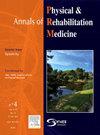慢性非特异性腰痛患者疼痛神经科学教育的有效性:荟萃分析综述
IF 4.6
3区 医学
Q1 REHABILITATION
Annals of Physical and Rehabilitation Medicine
Pub Date : 2025-09-26
DOI:10.1016/j.rehab.2025.102020
引用次数: 0
摘要
慢性非特异性腰痛(CNLBP)影响着全球数百万人,是造成残疾和医疗费用的主要原因。疼痛神经科学教育(PNE)旨在提高对疼痛机制的理解,减少适应不良的信念,促进积极的应对策略。目的评价疼痛神经科学教育(PNE)对成人慢性非特异性腰痛(CNLBP)患者疼痛强度、频率、残疾和生活质量的影响。DesignUmbrella review (UR)(普洛斯彼罗,CRD42023382825)。对8个数据库进行综合检索,检索时间为2014年4月至2024年4月。研究选择标准包括:患有CNLBP的成人,医疗保健专业人员提供的PNE干预措施,随机对照试验(RCTs)的系统评价(SRs)。排除:只关注心理或生理方面的研究。数据综合提取使用有效量表测量的疼痛强度、疼痛频率、残疾和生活质量数据。结果根据干预类型和评估期(短期或长期)显示。结果共纳入SRs 19例,5200名被试。五项研究(1120名参与者)显示PNE单独治疗短期疼痛明显减轻,但长期效果不一致。四项研究(860名参与者)显示PNE结合物理治疗或运动可以增强疼痛减轻。10项研究(3220名参与者)表明,PNE与其他教育和生物心理社会干预相结合可以更持久地减轻疼痛。6项研究被纳入定量评价PNE联合运动,疼痛MD(平均差异)为-1.11 (95% CI, -1.57至-0.66)。对于残疾,SMD(标准化平均差)为-0.42 (95% CI, -1.09至0.24)。结论:spne可降低CNLBP患者的疼痛强度,与物理治疗、运动或额外的教育和生物心理社会策略相结合可改善预后。建议采用包括PNE在内的多学科方法。需要使用标准化工具和不同人群进行进一步研究,以提高PNE干预措施的有效性和普遍性。这篇综述(UR)表明PNE可以有效地减轻CNLBP的疼痛强度和残疾,特别是当与物理治疗、运动或生物心理社会方法相结合时,它提出了关于PNE如何起作用的新假设。在不同的干预措施中加入PNE可能会提高参与者的结果,并支持更持久的疼痛缓解。RegistrationPROSPERO CRD42023382825。本文章由计算机程序翻译,如有差异,请以英文原文为准。
The effectiveness of pain neuroscience education in people with chronic non-specific low back pain: An umbrella review with meta-analysis
Background
Chronic non-specific low back pain (CNLBP) affects millions worldwide and is a major contributor to disability and healthcare costs. Pain neuroscience education (PNE) aims to improve understanding of pain mechanisms, reduce maladaptive beliefs, and promote active coping strategies.
Objective
To evaluate the effectiveness of pain neuroscience education (PNE) on pain intensity, frequency, disability, and quality of life in adults with chronic non-specific low back pain (CNLBP).
Design
Umbrella review (UR) (PROSPERO, CRD42023382825).
Literature search
A comprehensive search was conducted in 8 databases, covering April 2014 to April 2024.
Study selection criteria
Inclusion: adults with CNLBP, PNE interventions provided by healthcare professionals, and systematic reviews (SRs) of randomized controlled trials (RCTs). Exclusion: studies focusing solely on psychological or physical aspects.
Data synthesis
Data on pain intensity, pain frequency, disability, and quality of life measured using validated scales were extracted. The results were shown according to the type of intervention and the period evaluated (short or long-term).
Results
Nineteen SRs with 5200 participants were included. Five studies (1120 participants) showed significant short-term pain reductions with PNE alone but inconsistent long-term effects. Four studies (860 participants) showed enhanced pain reduction with PNE combined with physiotherapy or exercise. Ten studies (3220 participants) indicated that combining PNE with other educational and biopsychosocial interventions led to more sustained pain reductions. Six studies were included in a quantitative review assessing PNE combined with exercise, with MD (mean difference) for pain, -1.11 (95 % CI, -1.57 to -0.66). For disability, SMD (standardized mean difference) was -0.42 (95 % CI, -1.09 to 0.24).
Conclusions
PNE decreases pain intensity in CNLBP, with improved outcomes when combined with physiotherapy, exercise, or additional educational and biopsychosocial strategies. A multidisciplinary approach, including PNE, is recommended. Further research using standardized tools and diverse populations is needed to enhance the efficacy and generalizability of PNE interventions.
Perspective
This umbrella review (UR) demonstrates that PNE can effectively reduce pain intensity and disability in CNLBP, especially when combined with physiotherapy, exercise, or biopsychosocial approaches, and it launches new hypotheses about how PNE may work. Adding PNE to different interventions may enhance participant outcomes and support more sustained pain relief.
Registration
PROSPERO, CRD42023382825.
求助全文
通过发布文献求助,成功后即可免费获取论文全文。
去求助
来源期刊

Annals of Physical and Rehabilitation Medicine
Medicine-Rehabilitation
CiteScore
7.80
自引率
4.30%
发文量
136
审稿时长
34 days
期刊介绍:
Annals of Physical and Rehabilitation Medicine covers all areas of Rehabilitation and Physical Medicine; such as: methods of evaluation of motor, sensory, cognitive and visceral impairments; acute and chronic musculoskeletal disorders and pain; disabilities in adult and children ; processes of rehabilitation in orthopaedic, rhumatological, neurological, cardiovascular, pulmonary and urological diseases.
 求助内容:
求助内容: 应助结果提醒方式:
应助结果提醒方式:


